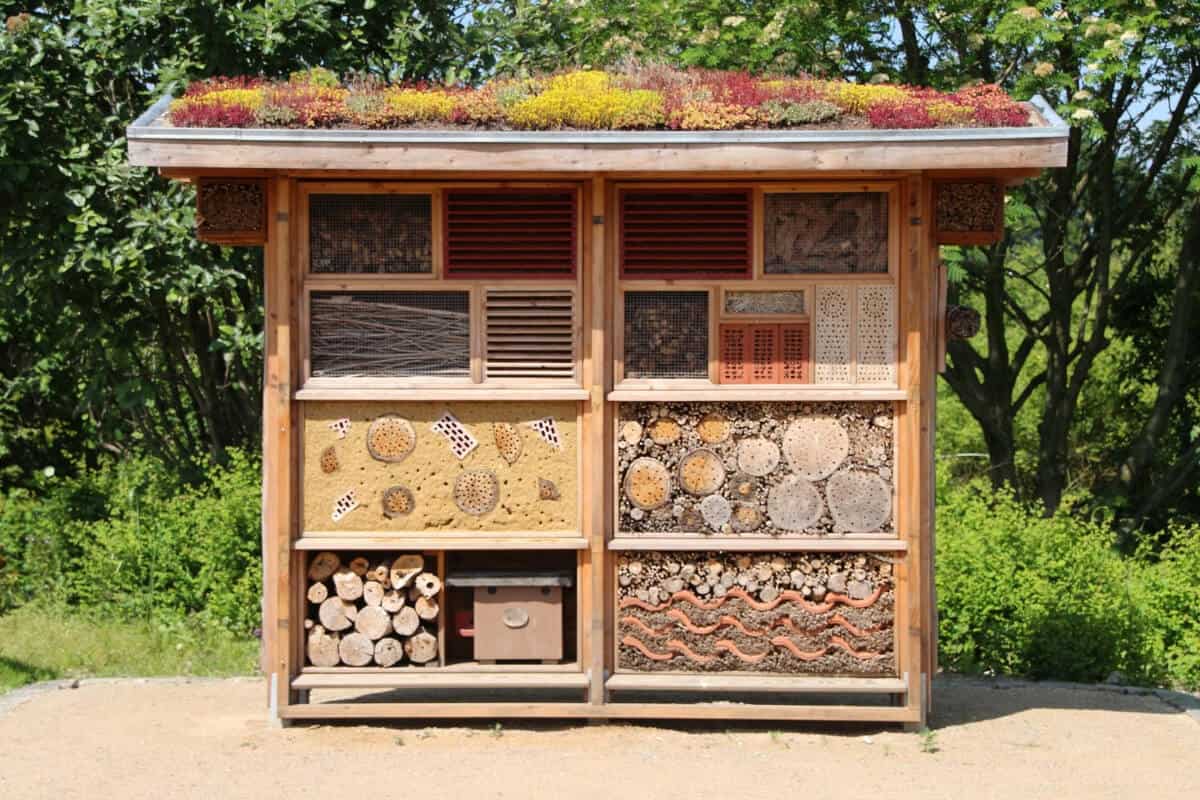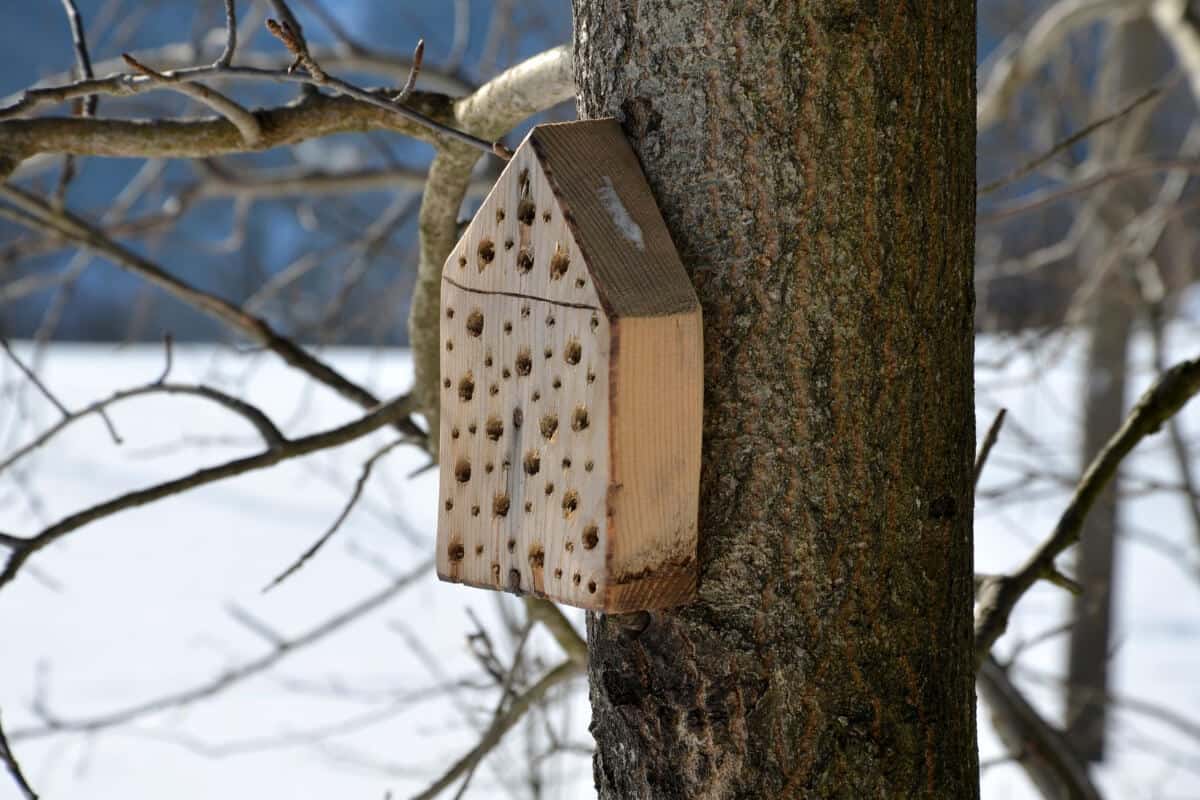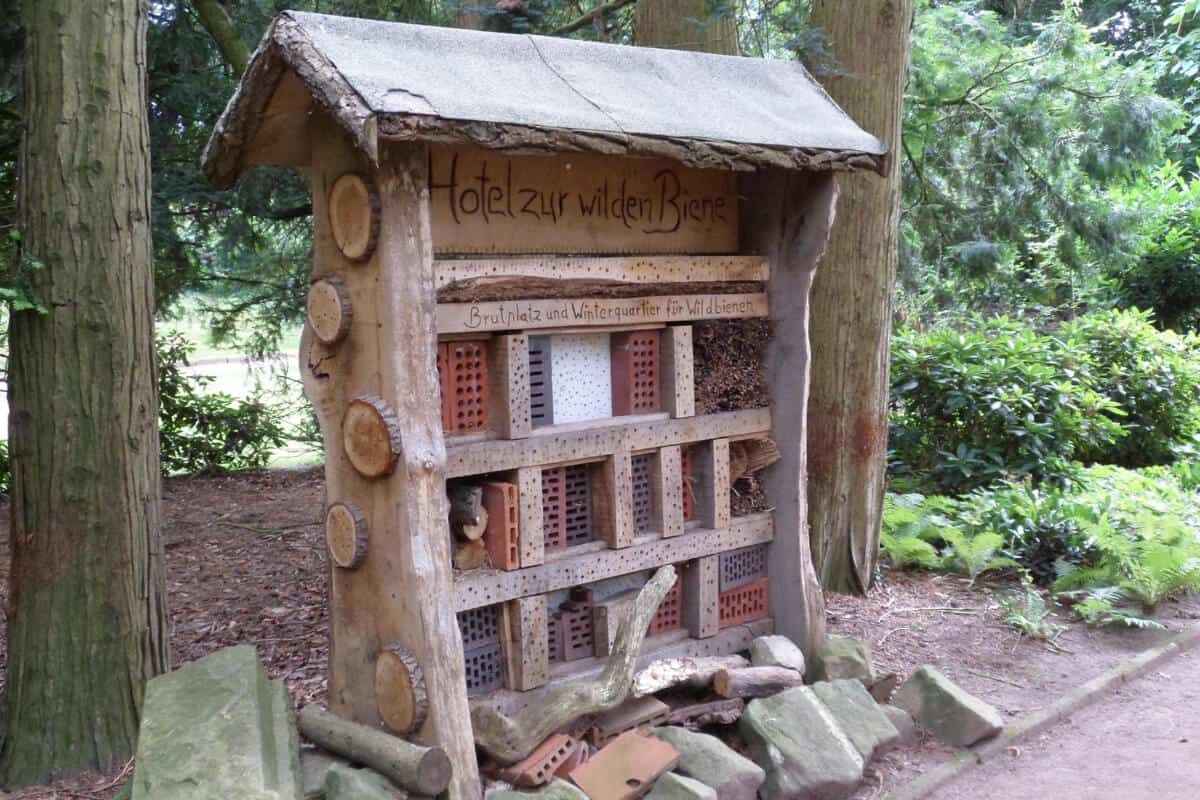Insect houses, sometimes called insect hotels, are very popular in gardens as they attract beneficial insects.
For people who don’t like bugs, it might be difficult to accept this concept, but a healthy garden always has a rich population of insects, arthropods, and other small animals.
It’s just a matter of attracting the ones that have positive effects, and there are many.
For instance, pollinator insects are essential for the reproduction of many plants. Other than the well-known bee, some beetles, butterflies, and some moths are also pollinators.
There are a few kinds of predator insects that are very useful as they prey on pests, such as aphids and caterpillars. Lady bugs, lacewings, and some beneficial wasps can all help you to limit the propagation of these harmful bugs.
Last but not least, a third category of good insects are the decomposers, which with their activity, can aid in clearing out dead plant matter and release minerals that improve the fertility of the soil.
- Related article: Types of Garden Insects
These insects are also essential if you want to keep a compost in your garden.
What Is a Beneficial Insect House?

Insect houses are man-made structures that can provide shelter for beneficial insects.
Normally, insects would be able to thrive without any human help, but nowadays our gardens are often lacking the places they need to make a safe home for themselves.
A well-tended garden won’t have many hiding places, such as piles of leaves or rotten wood. An insect house can solve this problem for the benefit of all involved.
Most times, not much is needed to make sure that your insect house effectively attracts bugs. In many cases, just its presence will suffice.
The critical aspects of an insect house to consider are its location and size, which will depend on the type of insect you want to lure in.
Also keep in mind that if you want to reap the benefits of these insects, you will have to avoid moving the house from one location to another, even during the winter.
At this time there might be insects hibernating inside, which will need to wake up to the same habitat they adapted to before the winter.
Types of Beneficial Insect Houses
There are different kinds of insect houses, based on the bugs they attract and the use they will make of them.
Some insects need nests, such as bees or wasps that don’t live in a hive. These solitary insects will prefer houses made of wood or stones, with holes of different sizes drilled into them.
This will allow them to burrow into these galleries to lay their insect eggs and deposit their prey.
The drilled holes should be deep enough to offer shelter and have smooth entrances in order not to damage the bees or wasps. This type of house should be placed in a warm and sheltered place.
Other insects will use houses to hibernate during the cold season, such as some butterflies and ladybugs.
Butterfly houses can be made of a simple bundle of leaves. They also love small sheltered places, such as cracks in houses and sheds.
Ladybugs prefer houses with many small cavities and dry wood shavings where a large number of them can hibernate together.
Their houses can be made out of a wooden box laying on its side and filled with some twigs.
Size also matters. Houses can be very small to attract single species, such as butterflies, mason bees, or ladybugs, or they can be large insect hotels.
These consist of different sections that can offer shelter to five or six different species at the same time. But it can be even simpler than this.
If you don’t want to build or buy an insect house, leaving piles of natural resources around your garden can be enough. Many insects will find shelter in a small pile of stones or leaves and other dead vegetation.
Rotting logs for example are perfect for wood-boring beetles whose larvae feast on decaying wood.
This setup will also attract woodland litter insects such as millipedes and woodlice which will then become a welcome source of food for birds.
As a general rule, keeping your insect house as natural as possible is always an effective and creative idea.
If you build or buy a wooden structure, always fill it with natural materials, such as dead leaves, twigs, bark, pine cones, and wood shavings.
This way you will provide an ideal nesting site for many different insects and increase the insect diversity of your garden.
Where Should a Beneficial Insect House Be Placed?

The location of your insect house depends on the type of insect you want to attract.
If you want insects to help you pollinate your plants and flowers, place a house close to your flower patches or blossoming trees. These insect hotspots will be very effective in keeping these helpful insects in your garden.
Choose a place that gets plenty of morning sun. This way your friendly insects will start to work bright and early. The place must be dry and sheltered from the wind and heavy rain.
Also, make sure your insect house is safely secured to prevent it from flying away in the case of strong winds, for example by drilling it on a fence at eye level.
Ensure that there’s a natural source of water nearby, or provide it yourself by filling a shallow dish with water. If you don’t already have a diversity of flowering plants in your garden, make sure to plant some near your insect house to attract solitary pollinators.
Having a small area with open earth nearby is a good idea too, as some pollinators use mud to protect their eggs.
If the insects you want to attract are natural predators, you will want to place the house directly on the ground or hang it low on some kind of support.
For these types of bugs, the best locations are moist and cool places in the shade. Also, make sure the ground you place them on is flat for more stability.
Take note that only a certain species of insects will use artificial habitats. Over seventy percent of native bee species, for instance, are ground nesters.
How to Buy a Beneficial Insect House
Insect houses are quite popular nowadays, so you’ll be able to find them easily.
Many online shops stock insect houses, but you will have to make sure you choose one that is sturdy and safe for the insects.
The most important thing to make sure of is that it’s made out of natural or recycled materials. The best houses will be a beautiful and natural addition to your successful garden.
Check that the house has a slanted roof to make sure the rain will drain away and not cause the whole structure to rot.
For the ones that have holes, make sure they are slanted downwards to allow rainwater to drain out. The surface of the openings should be smooth since an insect house with splinters won’t be colonized.
Avoid a wooden insect house made of soft wood, since it will easily crack and splinter.
Having said that, you can find different kinds of insect houses on Amazon, Woodside, and other online stores. The top-rated brands include Lulu Home, FUNPENY, Niteangel, Navaris, and Topadorn.
Make sure to choose one that is made from untreated wood that is free from wood protectant, varnish, and paint.
How Do You Make a Beneficial Insect House?

A wooden insect house filled with different natural materials is a very common type of insect house. The idea is to create many layers to provide shelter for different insects.
For the frame, you can upcycle old items in your house or backyard, such as pallets, bricks, and roof tiles. Turf works great to make a solid roof.
The inside of the structure can be filled with pretty much anything, ranging from dry leaves and twigs to barks, pinecones, and hollow stems.
Hollow bamboo canes are great to create chambers that can then be filled with leaves or straw. Make sure you fill in all the gaps, leaving only small spaces where the insects can fit.
Also, try to always use a range of materials to offer many options. This way you will attract a greater variety of insects with different needs.
To build a specific house for bees, the best is to start from a wooden or stone block and drill many small holes a couple of inches apart. The openings should be of different sizes and be tilted downwards to help drain rainwater.
Make sure to sand the openings very well, as a rough surface could easily damage the delicate bodies of the bees.
You can also add stems of blackberry, rose, or elderberry to your insect motels, which will provide a much-appreciated food source.
A very simple insect refuge can be made with a terracotta gardening pot. Just lay it on its side on the ground and fill it with different materials based on which insects you want to attract.
Beetles, woodlice, centipedes, millipedes, and spiders will be attracted to strips of bark. Ladybirds on the other hand love twigs, while centipedes, beetles, and harvestmen prefer dry leaves.
The bottom line is: be creative and use what you already have available to you and you will most certainly be able to attract many insect friends!
Beneficial Insect House Final Thoughts
The next time you are tempted to spray insecticide to eliminate garden pests remember that many products aren’t selective, so they will kill off both the harmful bugs and the beneficial ones.
It may look like you are solving the problem, but in fact, you are weakening the ecosystem, and thus the chances of your garden thriving.
That’s why the best choice you can make for the health of your garden is to increase its biodiversity by encouraging the presence of beneficial insect species through an insect house.
A couple of things to keep in mind though is to keep the insect hotel clean and free from mold. You can also consider replacing the tubes and nesting blocks every couple of months to avoid parasite buildup.
By keeping an insect house in your garden, you will be able to create a stable and well-balanced ecosystem.
Go beyond the surface and discover more about insects through these other awesome articles:
- Beneficial Bugs for Garden
- Beneficial Compost Insects
- Predatory Insects Advantages and Disadvantages
- Beneficial Insects for Houseplants
Sources:
- https://umdearborn.edu/environmental-interpretive-center/education-programs/pollination-project/insect-hotels
- https://citybugs.tamu.edu/2015/03/21/whats-the-buzz/
- https://www.uvm.edu/news/extension/building-bug-hotel
- https://portal.ct.gov/CAES/Fact-Sheets/Entomology/Approaches-to-the-Biological-Control-of-Insect-Pests

